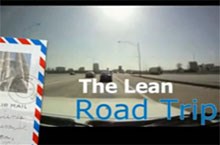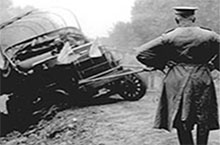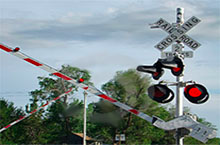
Lean tools have improved our lives in everything we do. Being able to recognize the use of lean tools to remove waste in our everyday lives sharpens our skills as lean practitioners. More importantly by using examples people can relate to from their everyday life, such as our road systems, helps convert non-lean people into believers.
The United States road system and infrastructure is a perfect example of how lean tools are used. The roads and visual controls weren’t always like this in the United States and are still not common around the world. The road system and the supporting laws that govern it were put in place to keep us safe and make us more efficient by reducing the time that it takes us to travel and transport goods.
Our current interstate highway system was created because of a United States Army drill in the summer of 1919. The Army convoy conducted a drill to move from Washington, D.C. to San Francisco. This mission’s goal was to establish a benchmark of the U.S. road system and was in reaction to the challenges that were noticed during World War I in moving troops. The complaints were that roads varied in drivability and overall condition. These roads made it hard to maintain and optimize the speed of travel, the 1919 convoy averaged less than six miles per hour. Additionally, the lack of visual controls, such as road signs, made it almost impossible to navigate easily through the maze of country roads that crisscrossed our nation. The results of this drill were shocking. It took the U.S. army sixty-two days to drive eighty-one army trucks and other vehicles 3,251 miles.

One of the service members in the 1919 convoy remembered the trouble and frustration that he experienced on this misadventure and set out to make some big changes. He eventually became the 34th president of the United States, and as president he was able to persuade Congress to enact the Federal-Aid Highway Act of 1956, creating what is now known as the Dwight D. Eisenhower Interstate Highway System. Now the same mission as the one conducted in 1919 could be completed in just two days!

The highway system features all types of visual management signals that help manage traffic and assist drivers in navigating the system safely. Imagine driving in a world where there were no traffic lights, stop signs, or marked lanes. Solid white, yellow, and dashed lines allow drivers to understand the road they are driving. Colored traffic lights add an important element of communication by indicating which driver has the right-of-way, when drivers should slow down or stop. Use of flashing lights helps to draw the driver’s attention to the road. Gated railroad crossings add yet another level of control by physically restricting the driver from ignoring the visual cues and proceeding across the railroad tracks.
There are so many examples of lean concepts in our driving reality, whether inside the car we drive or on the roads we travel. Lean is about making our lives easier so that we may enjoy every moment. Think about how lean and visual controls affect you the next time you drive. What do you think your experience would be like if you were on the roads in countries with less developed infrastructure and systems?
Click the link below to see the difference.
See the Comparison by clicking the video link to the Watch the Lean Road Trip on YouTube. https://www.youtube.com/watch?v=z6Msb0dgKpU


